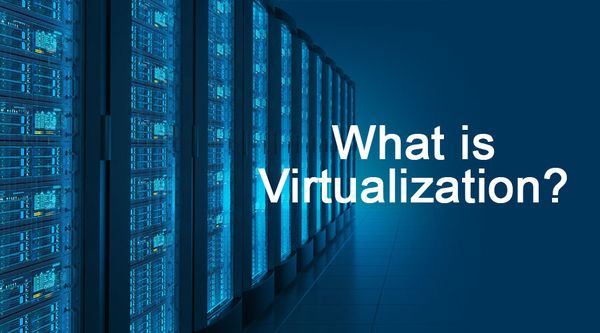
Top Data Center Challenges and Best Practices
December 18, 2019Why the Cloud Is More Secure Than Legacy Systems
December 23, 2019Do you ever wonder if your company is taking full advantage of your computer servers? The simple answer is no. It is estimated that most x86 servers run an average of only 10 to 15 percent of total capacity. If you have three servers for separate dedicated purposes (mail, web, and legacy applications) and they are all running at 15% capacity, you are wasting 85% capacity on each server, or a total of more than 2 ½ servers.
Virtualization can combine some of these tasks onto a single server and save your company money, energy, and time.

Photo Source: linuxsolutions
A History of Virtualization
Virtualization was extensively accepted and implemented in the early 2000s, but this virtualization technology has been around since the 1960s. The technology was developed to give multiple users simultaneous access to computers that performed batch processing. Virtualization didn’t gain traction as the time-sharing solution did. Time-sharing isolated users within operating systems, leading to other operating systems such as Unix and eventually Linux.
Virtualization started becoming popular in the 1990s as they helped solve a couple of different problems time-sharing could not: partitioning servers and run legacy applications on multiple operating systems types and versions. And second, servers started were being used so efficiently that some of them weren’t being used at all.
How Does Virtualization Work?
Hypervisor software is what makes virtualization possible. It is software that separates the physical resources from the virtual environments and the things that need these resources. Also known as a virtualization manager it can sit on top of an operating system like a laptop or it can be installed directly onto the hardware like a server. The latter is the way most businesses use a hypervisor. Regardless of how it is being used, hypervisors take your physical resources to allocate them so that different virtual environments can take advantage of them. The hypervisor relays messages from the user to the physical system via the virtual environment.

Photo Source: maketecheasier
What Are the Different Types of Virtualization?
There are different types of virtualization, the first one being Data Virtualization. Consolidating data into a single source can be beneficial. Data spread all over can be hard to manage. Data virtualization can allow data to be handled completely differently. Not only can virtualization consolidate data from different sources, but it can also make new incoming data easier to manage. The Data virtualization tool sits in from of the user’s different data sources and manages it by delivering data to where it is needed.
The next type is Desktop Virtualization. This allows users to arrange multiple operating systems on a single machine. This allows one central administrator to manage all virtual desktop environments and hundreds of machines at once. The use of Desktop Virtualization tools allows an easy and convenient way to perform mass configurations over many different desktops and systems.
Operating system virtualization is sometimes confused with Desktop Virtualization, but there are some major differences. This type of virtualization happens at the main component of the Linux operating system—the Linux Kernel. It’s an easier way to manage Linux and Windows environments together. Using operating system virtualization can reduce hardware costs, increase security by being able to monitor everything from one location, and will cut software update times.
Another type of virtualization that can help with business operations is Server Virtualization. Servers are what process the high volume of specific tasks so our desktops and laptops don’t need to do all the work and can focus on other things we need them to do. Virtualization divides and allocates the workload so that these components can be used to operate various tasks.
Network Function Virtualization is the final type of we be discussing. This type of virtualization assigns and distributes key functions in the network. These functions are packaged together into a new network and assigned a new environment. This lowers the number of physical parts, which include cables, routers, switches, and servers.

Photo Source: computerworld
Should You Virtualize?
Virtualization is a great solution for many businesses. Here are a couple of situations where your business could potentially virtualize its systems.
Your company should virtualize if want or need to create extra space. Some businesses use large extra rooms to house their server racks and IT personnel to main them. Paying for extra rooms can be expensive, and could be utilized in other ways if you virtualize your system. If you have limited office space, virtualization will make better use of you have.
Virtualize if your company relies on technology. If your company needs technology to operate, it could be beneficial to virtualize. Your company can reduce overall costs by reducing the number of hardware costs.
Your company should virtualize if you can cover the upfront costs. In time, virtualization will reduce your business costs and streamline your operations. But like most things, it needs an initial investment. Virtualization may be too costly for small businesses. Finding a service that can help you see if it’s a good fit for your company and is crucial.
Within this same idea, your company shouldn’t virtualize if it’s very small. But your company could virtualize if you have more than 20 employees. Virtualizing a small company just wouldn’t make sense. If your business has less than 20 employees, traditional servers are enough for your company’s needs. There wouldn’t be much cost-savings if your company has less than 20 employees.

Photo Source: uptimeinstitute
Why Combining Virtualization and Colocation Is a Good Idea?
Data center colocation and virtualization can be beneficial for a data-driven business environment. Merging the benefits of both can help your company be more productive. Here are some reasons the colocation and virtualization can go hand in hand: improved virtualization strategy. Availability of colocation expertise and tools, improved disaster recovery, use of colocation environments as a sandbox, improve management of resource spikes, availability of secure multi-tenant environments.
The business benefits of data center colocation are undeniable, from scalability, security, and sustainability, collocating can help your business in many ways. And with the combined power of virtualization, the possibilities are endless.
Conclusion
The use of virtualization and migrating physical systems into a virtual environment has many advantages for larger businesses. Running multiple operating systems and applications on a single server can be beneficial for many companies. This form of consolidation should be looked at for most growing businesses. Saving space and saving money while streamlining and increasing the overall performance of your system is something all businesses would want.

